Infant CPR
Cardiac arrest can happen anytime anywhere. If a child or infant’s heart stops, you should provide immediate CPR - compressions with breaths - until help arrives.
Infants usually have healthy hearts. Often, an infant’s heart stops because the infant can’t breathe or is a having trouble breathing.
By learning the skills of CPR and choking relief you can be better prepared to save a life.

Learn CPR. Practice. Share.

Learn the lifesaving skills of CPR, anywhere or any time. Practice and maintain skills so that you can be prepared to act in an emergency. Share this lifesaving knowledge with family and friends.
It’s important to remember: Unresponsive + No breathing or only gasping = Provide CPR
Learn How to Perform Child and Infant CPR
If a child or infant's heart stops, you should provide compressions with breaths.
- Step 1
- Make sure the scene is safe.
- Step 2
- Shout for help.
- Step 3
- Provide CPR with compressions and breaths.
- Child CPR
- Push on the middle of the chest 30 times at a depth of 2 inches with 1 or 2 hands.
- Infant CPR
- Push on the middle of the chest 30 times at a depth of 1½ inches with 2 fingers.
Use the AED as soon as it arrives. Continue CPR until EMS arrives.
Resources for Infant CPR and Child CPR
Infant Choking reference card
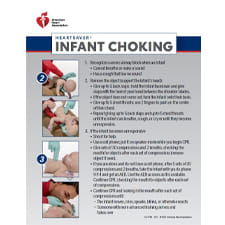
Infant CPR reference card
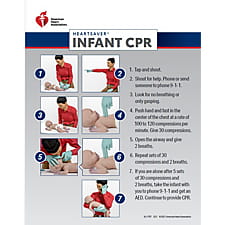
Child Choking reference card
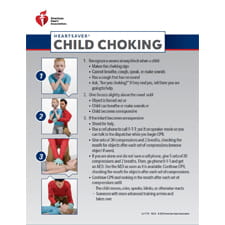
Child CPR AED reference card
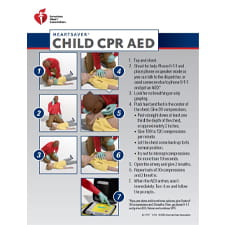
Infant Child Car Safety

- Make sure that children younger than 13 years are buckled up in the back seat.
- Have them keep their arms and legs inside, not hanging out of the window.
Never leave a child alone in the car:
- Put your phone or bag on the floorboard in the back so that you’ll always check the back seat before locking the car.
- Keep a large stuffed animal in the child’s car seat and move it up front whenever you buckle in the child. This will help you remember that if the stuffed animal is up front, the child is in the back.
- Tell your child’s day care that you’ll always phone if your child won’t be there as scheduled.
1 out of 10 Babies are admitted to NICUs
There is always an immediate community need with Hospitals and Neonatal Intensive Care Units needing help to provide hands-on CPR and choking relief education to families.
The transition for high-risk infants from NICU (Neonatal Intensive Care Unit) to home is a critical time. It’s important to provide families and caregivers with training they’ll need in case their infant has a respiratory or cardiac emergency at home.
With hospital resources stretched to their limits, babies continue to be born.
- 3.8 million babies are born in the U.S. every year: on average over 300,000 babies per month.
- 1 out of 10 of these babies are born too early (preterm) and go to the NICU for various health reasons.
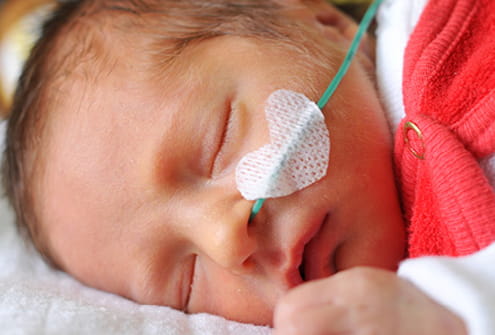
Empower Yourself to Save a Life in Just 20 Minutes

The kit contains all the necessary tools to help you react in case of a respiratory or cardiac emergency at home. The AHA’s Infant CPR Anytime® personal learning program teaches the core skills of infant CPR and choking relief.
Adjusting to life at home with an infant can be a bit overwhelming, but with proper preparation you’ll be equipped with the knowledge to care for your little one. With Infant CPR Anytime, parents, families, caregivers, and friends can all learn lifesaving skills with about 20 minutes of self-directed instruction.
The Best Infant CPR Courses
NEW Infant CPR Anytime Kit

The new Infant CPR Anytime is cobranded with the American Academy of Pediatrics, contains everything needed to learn the lifesaving skills of infant CPR, choking relief, and infant injury prevention in about 30 minutes.
-
Is portable, allowing families to easily share it with friends, babysitters, and caregivers
- Great solution for Neonatal Intensive Care Units (NICUs) in hospitals to train new parents
- Streaming video offers CPR and choking relief skills practice that can be used with the included inflatable Mini Baby® CPR manikin that clicks when you’ve pushed to the proper depth
- New, Infant CPR Anytime® Interactive App allows learners to enhance their CPR training experience on a mobile device
- Is bilingual (English/Spanish)
After completing Infant CPR Anytime, you’ll feel confident to respond if your infant chokes or becomes unresponsive. The power to save the most precious life of all, the life of your baby, is in your hands.
Heartsaver® Pediatric First Aid CPR AED

If you want a more advanced CPR course with a course completion card Heartsaver® Pediatric First Aid CPR AED is perfect for babysitters, day care workers, parents and family members looking to be prepared for an infant cardiac emergency.
Get more information on Heartsaver Pediatric First Aid CPR AED
 Login
Login
